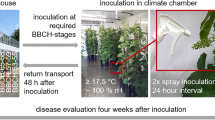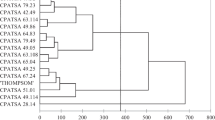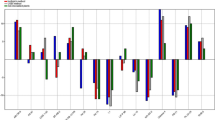Abstract
The use of resistant individuals obtained through a breeding program, aimed at decreasing chemical treatments, is one of the most promising strategies for control of downy mildew caused by Plasmopara viticola in grapevine. In this study, 869 hybrid grape individuals, obtained by crossing the resistant Regent grape cultivar with sensitive Alphonse Lavallée, were tested after artificial inoculation of detached leaves by drops of the pathogen inoculum. Sporulation severity, as visual evaluation of sporulation density including necrosis, and sporulation incidence were scored to assess resistance level, then the sporulation area (mm2) was measured for each individual. The criterium of sporulation incidence could not describe all resistance levels. Sporulation area made it possible to measure the entire area in detail for how the pathogen spread at the inoculation site. Sporulation area was not fully consistent with sporulation severity. In this context, a new scale for sporulation area was developed to determine resistance level to the pathogen by taking into account the distribution of sporulation area values within those obtained from sporulation severity scales. Six categories ranging from 0 to 0.05 mm2 (extremely resistant-ER) to ≥15.1 mm2 (extremely sensitive-ES) were defined. 43 of the 869 individuals tested through the three evaluation criteria, in which no sporulation was observed, and 18 additional individuals with sporulation area of <0.05 mm2 were scored in the ER group. Microscopic analysis confirmed findings for the ER group and other resistance levels. The authors suggest that the scale of sporulation area will be useful for assessment of resistance to downy mildew on grapevine leaves.





Similar content being viewed by others
References
Alonso-Villaverde, V., Voinesco, F., Viret, O., Spring, J. L., & Gindro, K. (2011). The effectiveness of stilbenes in resistant Vitaceae: Ultrastructural and biochemical events during Plasmopara viticola infection process. Plant Physiology and Biochemistry, 49(3), 265–274. https://doi.org/10.1016/j.plaphy.2010.12.010.
Bellin, D., Peresotti, E., Meerdinoglu, D., Wiedemann-Merdinoglu, S., Adam-Blondon, A. F., Cipriani, G., et al. (2009). Resistance to Plasmopara viticola in grapevine ‘Bianca’ is controlled by a major dominant gene causing localised necrosis at infection site. Theoretical and Applied Genetics, 120, 163–176. https://doi.org/10.1007/s00122-009-1167-2.
Blasi, P., Sophie, B., Wiedemann-Merdinoglu, S., Prado, E., Rühl, E. H., Meestre, P., & Merdinoglu, D. (2011). Construction of a reference linkage map of Vitis amurensis and genetic mapping of Rpv8, a locus conferring resistance to grapevine downy mildew. Theoretical and Applied Genetics, 123, 43–53. https://doi.org/10.1007/s00122-011-1565-0.
Blum, M., Waldner, M., & Gisi, U. (2010). A single point mutation in the novel PvCesA3 gene confers resistance to the carboxylic acid amide fungicide mandipropamid in Plasmopara viticola. Fungal Genetics and Biology, 47(6), 499–510. https://doi.org/10.1016/j.fgb.2010.02.009.
Boso, S., & Kassemeyer, H. H. (2008). Different susceptibility of European grapevine cultivars for downy mildew. Vitis, 47(1), 39–49.
Boso, S., Santiago, J. L., & Martinez, M. C. (2005). A method to evaluate downy mildew resistance in grapevine. Agronomy for Sustainable Development, 25(1), 163–165. https://doi.org/10.1051/agro:2004062.
Boso, S., Martínez, M. C., Unger, S., & Kassemeyer, H. H. (2006). Evaluation of foliar resistance to downy mildew in different cv. Albariño clones. Vitis, 45(1), 23–27. https://doi.org/10.1016/j.cropro.2014.04.018.
Boso, S., Alonso-Villaverde, V., Gago, P., Santiago, J. L., & Martínez, M. C. (2014). Susceptibility to downy mildew (Plasmopara viticola) of different Vitis varieties. Crop Protection, 63, 26–35.
Boso, S., Gago, P., Santiago, J. L., de la Fuente, M., & Martínez, M. C. (2019). Factors affecting the vineyard populational diversity of Plasmopara viticola. The Plant Pathology Journal, 35(2), 125–136. https://doi.org/10.5423/PPJ.OA.09.2018.0194.
Bove, F., Bavaresco, L., Caffi, T., & Rossi, V. (2019). Assessment of resistance components for improved phenotyping of grapevine varieties resistant to downy mildew. Frontiers in Plant Science, 10, 1559. https://doi.org/10.3389/fpls.2019.01559.
Buonassisi, D., Colombo, M., Migliaro, D., Dolzani, C., Peressotti, E., Mizzotti, C., Velasco, R., Masiero, S., Perazzolli, M., & Vezzulli, S. (2017). Breeding for grapevine downy mildew resistance: A review of ‘omics’ approaches. Euphytica, 213, 103. https://doi.org/10.1007/s10681-017-1882-8.
Cadle-Davidson, L. (2008). Variation within and between Vitis spp. for foliar resistance to the downy mildew pathogen Plasmopara viticola. Plant Disease, 92(11), 1577–1584. https://doi.org/10.1094/PDIS-92-11-1577.
Calonnec, A., Wiedemann-Merdinoglu, S., Delière, L., Cartolaro, P., Schneider, C., & Delmotte, F. (2013). The reliability of leaf bioassays for predicting disease resistance on fruit: A case study on grapevine resistance to downy and powdery mildew. Plant Pathology, 62(3), 533–544. https://doi.org/10.1111/j.1365-3059.2012.02667.x.
Chen, W. J., Delmotte, F., Richard-Cervera, S., Douence, L., Greif, C., & Corio-Costet, M. F. (2007). At least two origins of fungicide resistance in grapevine downy mildew populations. Applied and Environmental Microbiology, 73(16), 5162–5172.
Delmas, C., Fabre, F., Jolivet, J., Mazet, I., Cervera, S. R., Deliere, L., & Delmotte, F. (2016). Adaptation of a plant pathogen to partial host resistance: Selection for greater aggressiveness in grapevine downy mildew. Evolutionary Applications, 9(5), 709–725. https://doi.org/10.1111/eva.12368.
Delmotte, F., Mestre, P., Schneider, C., Kassemeyer, H. H., Kozma, P., Cervera, S., et al. (2014). Rapid and multiregional adaptation to host partial resistance in plant pathogenic oomycete: Evidence from European populations of Plasmopara viticola, the causal agent of grapevine downy mildew. Infection, Genetics and Evolution, 27, 500–508. https://doi.org/10.1016/j.meegid.2013.10.017.
Eibach, R., & Töpfer, R. (2003). Success in resistance breeding: “Regent” and its steps into the market, Proceedings of the VIIIth International Conference on Grape Genetics and Breedings, Kecskemét, Hungary. Acta Horticulturae, 603, 687-691. https://doi.org/10.17660/ActaHortic.2003.603.95.
Eibach, R., Zyprian, E., Welter, L., & Töpfer, R. (2007). The use of molecular markers for pyramiding resistance genes in grapevine breeding. Vitis, 46(3), 120–124.
Feechan, A., Anderson, C., Torregrosa, L., Jermakow, A., Mestre, P., Wiedemann-Merdinoglu, S., Merdinoglu, D., Walker, A. R., Cadle-Davidson, L., Reisch, B., Aubourg, S., Bentahar, N., Shrestha, B., Bouquet, A., Adam-Blondon, A. F., Thomas, M. R., & Dry, I. B. (2013). Genetic dissection of a TIR-NB-LRR locus from the wild north American grapevine species Muscadinia rotundifolia identifies paralogous genes conferring resistance to major fungal and oomycete pathogens in cultivated grapevine. The Plant Journal, 76(4), 661–674. https://doi.org/10.1111/tpj.12327.
Gaforio, L., Cabello, F., & Muñoz Organero, G. (2015). Evaluation of resistance to downy mildew in grape varieties grown in a Spanish collection. Vitis, 54(Special Issue), 187–191.
Galet, P. (1979). A practical ampelography. Ithaca: Cornell University Press.
Gessler, C., Pertot, I., & Perazzoli, M. (2011). Plasmopara viticola: A review of knowledge on downy mildew of grapevine and effective disease management. Phytopathologia Mediterranea, 50(1), 3–44.
Gindro, K., Pezet, R., & Viret, O. (2003). Histological study of the responses of two Vitis vinifera cultivars (resistant and susceptible) to Plasmopara viticola infections. Plant Physiology and Biochemistry, 41(9), 846–853. https://doi.org/10.1016/S0981-9428(03)00124-4.
Gindro, K., Spring, J. L., Pezet, R., Richter, H., & Viret, O. (2006). Histological and biochemical criteria for objective and early selection of grapevine cultivars resistant to Plasmopara viticola. Vitis, 45, 191–196.
Gindro, K., Alonso-Villaverde, V., Voinesco, F., Spring, J. L., Viret, O., & Dubuis, P. (2012). Susceptibility to downy mildew in grape clusters: New microscopical and biochemical insights. Plant Physiology and Biochemistry, 52, 140–146. https://doi.org/10.1016/j.plaphy.2011.12.009.
Gisi, U. (2002). Chemical control of downy mildews. In P. T. N. Spencer, U. Gisi, & A. Lebeda (Eds.), Advances in downy mildew research (pp. 119–159). Dordrecht: Kluwer Academic Publishers.
Gobbin, D., Rumbou, A., Linde, C. C., & Gessler, C. (2006). Population genetic structure of Plasmopara viticola after 125 years of colonization in European vineyards. Molecular Plant Pathology, 7(6), 519–531. https://doi.org/10.1111/j.1364-3703.2006.00357.x.
Godard, S., Slacanin, I., Viret, O., & Gindro, K. (2009). Induction of defence mechanisms in grapevine leaves by emodin- and antraquinone-rich plant extracts and their conferred resistance to downy mildew. Plant Physiology and Biochemistry, 47(9), 827–837. https://doi.org/10.1016/j.plaphy.2009.04.003.
Gómez-Zeledón, J., Zipper, R., & Spring, O. (2013). Assessment of phenotypic diversity of Plasmopara viticola on Vitis genotypes with different resistance. Crop Protection, 54, 221–228. https://doi.org/10.1016/j.cropro.2013.08.015.
Gómez-Zeledón, J., Kaiser, M., & Spring, O. (2017). Exploring host-pathogen combinations for compatible and incompatible reactions in grapevine downy mildew. European Journal of Plant Pathology, 149, 1–10. https://doi.org/10.1007/s10658-017-1156-2.
Jürges, G., Kassemeyer, H. H., & Dürrenberger, M. (2009). The mode of interaction between Vitis and Plasmopara viticola Berk. & Curt. Ex de Bary depends on the host species. Plant Biology, 11(6), 886–898. https://doi.org/10.1111/j.1438-8677.2008.00182.x.
Kiefer, B., Rieman, M., Kassemeyer, H. H., & Nick, P. (2002). The host guides morphogenesis and stomatal targeting in grapevine pathogen Plasmopara viticola. Planta, 215(3), 387–393. https://doi.org/10.1007/s00425-002-0760-2.
Kim Khiook, I. L., Schneider, C., Heloir, M. C., Bois, B., Daire, X., Adrian, M., & Trouvelot, S. (2013). Image analysis methods for assessment of H2O2 production and Plasmopara viticola development in grapevine leaves: Application to the evaluation of resistance to downy mildew. Journal of Microbiological Methods, 95(2), 235–244. https://doi.org/10.1016/j.mimet.2013.08.012.
Kortekamp, A., Wind, R., & Zyprian, E. (1998). Investigation of the interaction of Plasmopara viticola with susceptible and resistant grapevine cultivars. Journal of Plant Disease and Protection, 105(5), 475–488.
Li, X., Yin, L., Ma, L., Zhang, Y., An, Y., & Lu, J. (2016). Pathogenicity variation and population genetic structure of Plasmopara viticola in China. Journal of Phytopathology, 164(11–12), 863–873. https://doi.org/10.1111/jph.12505.
Liu, R., Wang, L., Zhu, J., Chen, T., Wang, Y., & Xu, Y. (2015). Histological responses to downy mildew in resistant and susceptible grapevines. Protoplasma, 252(1), 259–270.
Marchive, C., Léon, C., Kappel, C., Cautos-Thévenot, P., Corio-Costet, M. F., Delrot, S., & Lauvergeat, V. (2013). Over-expression of VvWRKY1 in grapevines induces expression of jasmonic acid pathway-relatted genes and confers higher tolerance to the downy mildew. PLoS One, 8, e54185. https://doi.org/10.1371/journal.pone.0054185.
Marguerit, E., Boury, C., Manicki, A., Donnart, M., Butterlin, G., Némorin, A., Wiedemann-Merdinoglu, S., Merdinoglu, D., Ollat, N., & Decroocq, S. (2009). Genetic dissection of sex determinism, inflorescence morphology and downy mildew resistance in grapevine. Theoretical and Applied Genetics, 118, 1261–1278. https://doi.org/10.1007/s00122-009-0979-4.
Matasci, C. L., Gobbin, D., Schärer, H. J., Tamm, L., & Gessler, C. (2008). Selection for fungicide resistance throughout a growing season in populations of Plasmopara viticola. European Journal of Plant Pathology, 120, 79–83. https://doi.org/10.1007/s10658-007-9190-0.
Peressotti, E., Duchêne, E., Merdinoglu, D., & Mestre, P. (2011). A semi-automatic non-destructive method to quantify grapevine downy mildew sporulation. Journal of Microbiological Methods, 84(2), 265–271. https://doi.org/10.1016/j.mimet.2010.12.009.
Pezet, R., Gindro, K., Viret, O., & Spring, J. L. (2004). Glycosylation and oxidative dimerization of resveratrol are respectively associated to sensitivity and resistance of grapevine cultivars to downy mildew. Physiological and Molecular Plant Pathology, 65(6), 297–303. https://doi.org/10.1016/j.pmpp.2005.03.002.
Projongiai, T., Poolsawat, O., Pornbungkerd, P., Wongkaew, S., & Tantasawatt, P. A. (2014). Evaluation of grapevines for resistance to downy mildew (Plasmopara viticola) under laboratory and field conditions. South African Journal of Enology and Viticulture, 35(1), 43–50.
Rouxel, M., Papura, D., Nogueira, M., Machefer, V., Damien, D., Cervera, S. C., et al. (2012). Microsatellite markers for characterization of native and introduced populations of Plasmopara viticola, the causal agent of grapevine downy mildew. Applied and Environmental Microbiology, 78(17), 6337–6340. https://doi.org/10.1128/AEM.01255-12.
Rouxel, M., Mestre, P., Comont, G., Lehman, B. L., Schilder, A. &, Delmotte, F. (2013). Phylogenetic and experimental evidence for host-specialized cryptic species in a biotrophic oomycete. New Phytologist, 197(1): 251–263. https://doi.org/10.1111/nph.12016.
Scherer, E., & Gisi, U. (2006). Characterization of genotype and mating type in European isolates of Plasmopara viticola. Journal of Phytopathology, 154(7–8), 489–495. https://doi.org/10.1111/j.1439-0434.2006.01136.x.
Schwander, F., Eibach, R., Fechter, I., Hausmann, L., Zyprian, E., & Topfer, R. (2012). Rpv10: A new locus from the Asian Vitis gene pool for pyramiding downy mildew resistance loci in grapevine. Theoretical and Applied Genetics, 124, 163–176. https://doi.org/10.1007/s00122-011-1695-4.
Townsend, G. R., & Heuberger, J. W. (1943). Methods for estimating losses caused by diseases in fungicide experiments. Plant Disease Reporter, 27, 340–343.
Unger, S., Bueche, C., Boso, S., & Kassemeyer, H. H. (2007). The course of colonization of two different Vitis genotypes by Plasmopara viticola indicates compatible and incompatible host-pathogen interactions. Phytopathology, 97, 780–786. https://doi.org/10.1094/PHYTO-97-7-0780.
Van Heerden, C. J., Burger, P., Vermeulen, A., & Prins, R. (2014). Detection of downy and powdery mildew resistance QTL in a ‘regent’ X ‘RedGlobe’ population. Euphytica, 200, 281–295. https://doi.org/10.1007/s10681-014-1167-4.
Venuti, S., Copetti, D., Foria, S., Falginella, L., Hoffmann, S., Bellin, D., Cindrić, P., Kozma, P., Scalabrin, S., Morgante, M., Testolin, R., & di Gaspero, G. (2013). Historical intogression of downy mildew resistance gene Rpv12 from the Asian species Vitis amurensis into grapevine varieties. PLoS One, 8, e61228. https://doi.org/10.1371/journal.pone.0061228.
VIVC, 2020. Vitis international variety catalogue. http://www.vivc.de. Accessed 25 June 2020.
Yin, L., Zhang, Y., Hao, Y., & Lu, J. (2014). Genetic diversity and population structure of Plasmopara viticola in China. European Journal of Plant Pathology, 140(2), 365–376. https://doi.org/10.1007/s10658-014-0470-1.
Zhang, W., Manawasinghe, I. S., Zhao, W., Xu, J., Brooks, S., Zhao, X., et al. (2017). Multiple gene genealogy reveals high genetic diversity and evidence for multiple origins of Chinese Plasmopara viticola population. Scientific Reports, 7, 17304. https://doi.org/10.1038/s41598-017-17569-7.
Zyprian, E., Ochßner, I., Schwander, F., Šimon, S., Hausmann, L., Bonow-Rex, M., Moreno-Sanz, P., Grando, M. S., Wiedemann-Merdinoglu, S., Merdinoglu, D., Eibach, R., & Töpfer, R. (2016). Quantitative trait loci affecting pathogen resistance and ripening of grapevines. Molecular Genetics and Genomics, 291(4), 1573–1594. https://doi.org/10.1007/s00438-016-1200-5.
Acknowledgements
This work was supported by the Turkish Scientific and Technical Research Council (TUBİTAK) (Project no:1150176). The authors gratefully acknowledge TUBITAK for financial support and Martha Rowe (University of Nebraska-Lincoln) for improving the language and for useful remarks.
Author information
Authors and Affiliations
Corresponding author
Ethics declarations
Human and animal rights
No human and/or animal participants was present in this research.
Informed consent
All authors of this study consent to this submission.
Conflict of interest
The authors declare no conflict of interest.
Rights and permissions
About this article
Cite this article
Özer, N., Uzun, H.İ., Aktürk, B. et al. Resistance assessment of grapevine leaves to downy mildew with sporulation area scoring. Eur J Plant Pathol 160, 337–348 (2021). https://doi.org/10.1007/s10658-021-02247-2
Accepted:
Published:
Issue Date:
DOI: https://doi.org/10.1007/s10658-021-02247-2




